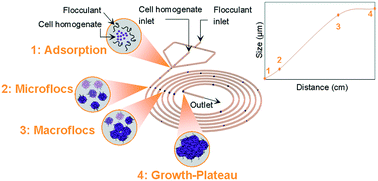Our official English website, www.x-mol.net, welcomes your
feedback! (Note: you will need to create a separate account there.)
Flocculation on a chip: a novel screening approach to determine floc growth rates and select flocculating agents†
Lab on a Chip ( IF 6.1 ) Pub Date : 2018-01-18 00:00:00 , DOI: 10.1039/c7lc00793k Anand N. P. Radhakrishnan 1, 2, 3, 4 , Marco P. C. Marques 1, 2, 3, 4 , Matthew J. Davies 1, 2, 3, 4 , Brian O'Sullivan 1, 2, 3, 4 , Daniel G. Bracewell 1, 2, 3, 4 , Nicolas Szita 1, 2, 3, 4
Lab on a Chip ( IF 6.1 ) Pub Date : 2018-01-18 00:00:00 , DOI: 10.1039/c7lc00793k Anand N. P. Radhakrishnan 1, 2, 3, 4 , Marco P. C. Marques 1, 2, 3, 4 , Matthew J. Davies 1, 2, 3, 4 , Brian O'Sullivan 1, 2, 3, 4 , Daniel G. Bracewell 1, 2, 3, 4 , Nicolas Szita 1, 2, 3, 4
Affiliation

|
Flocculation is a key purification step in cell-based processes for the food and pharmaceutical industry where the removal of cells and cellular debris is aided by adding flocculating agents. However, finding the best suited flocculating agent and optimal conditions to achieve rapid and effective flocculation is a non-trivial task. In conventional analytical systems, turbulent mixing creates a dynamic equilibrium between floc growth and breakage, constraining the determination of floc formation rates. Furthermore, these systems typically rely on end-point measurements only. We have successfully developed for the first time a microfluidic system for the study of flocculation under well controlled conditions. In our microfluidic device (μFLOC), floc sizes and growth rates were monitored in real time using high-speed imaging and computational image analysis. The on-line and in situ detection allowed quantification of floc sizes and their growth kinetics. This eliminated the issues of sample handling, sample dispersion, and end-point measurements. We demonstrated the power of this approach by quantifying the growth rates of floc formation under forty different growth conditions by varying industrially relevant flocculating agents (pDADMAC, PEI, PEG), their concentration and dosage. Growth rates between 12.2 μm s−1 for a strongly cationic flocculant (pDADMAC) and 0.6 μm s−1 for a non-ionic flocculant (PEG) were observed, demonstrating the potential to rank flocculating conditions in a quantitative way. We have therefore created a screening tool to efficiently compare flocculating agents and rapidly find the best flocculating condition, which will significantly accelerate early bioprocess development.
中文翻译:

絮凝在芯片上:一种新颖的筛选方法,可确定絮凝物的生长速率并选择絮凝剂†
絮凝是食品和制药行业基于细胞的工艺中的关键纯化步骤,在该过程中,通过添加絮凝剂可帮助去除细胞和细胞碎片。然而,找到最合适的絮凝剂和最佳条件以实现快速有效的絮凝不是一件容易的事。在常规分析系统中,湍流混合会在絮凝物的生长和破裂之间建立动态平衡,从而限制了絮凝物形成速率的确定。此外,这些系统通常仅依赖于端点测量。我们首次成功开发了一种微流体系统,用于在良好控制的条件下研究絮凝。在我们的微流控设备(μFLOC)中,使用高速成像和计算图像分析实时监测絮状物的大小和生长速率。上线和原位检测可以量化絮凝物的大小及其生长动力学。这消除了样品处理,样品分散和终点测量的问题。我们通过改变工业上相关的絮凝剂(pDADMAC,PEI,PEG),浓度和剂量来量化四十种不同生长条件下絮凝物的生长速率,从而证明了这种方法的功效。之间12.2微米的增长速率-1为强阳离子絮凝剂(PDADMAC)和0.6微米小号-1观察到非离子絮凝剂(PEG)的浓度,证明了对絮凝条件进行定量排名的潜力。因此,我们创建了一种筛选工具,可以有效地比较絮凝剂并迅速找到最佳的絮凝条件,这将显着加快早期生物工艺的发展。
更新日期:2018-01-18
中文翻译:

絮凝在芯片上:一种新颖的筛选方法,可确定絮凝物的生长速率并选择絮凝剂†
絮凝是食品和制药行业基于细胞的工艺中的关键纯化步骤,在该过程中,通过添加絮凝剂可帮助去除细胞和细胞碎片。然而,找到最合适的絮凝剂和最佳条件以实现快速有效的絮凝不是一件容易的事。在常规分析系统中,湍流混合会在絮凝物的生长和破裂之间建立动态平衡,从而限制了絮凝物形成速率的确定。此外,这些系统通常仅依赖于端点测量。我们首次成功开发了一种微流体系统,用于在良好控制的条件下研究絮凝。在我们的微流控设备(μFLOC)中,使用高速成像和计算图像分析实时监测絮状物的大小和生长速率。上线和原位检测可以量化絮凝物的大小及其生长动力学。这消除了样品处理,样品分散和终点测量的问题。我们通过改变工业上相关的絮凝剂(pDADMAC,PEI,PEG),浓度和剂量来量化四十种不同生长条件下絮凝物的生长速率,从而证明了这种方法的功效。之间12.2微米的增长速率-1为强阳离子絮凝剂(PDADMAC)和0.6微米小号-1观察到非离子絮凝剂(PEG)的浓度,证明了对絮凝条件进行定量排名的潜力。因此,我们创建了一种筛选工具,可以有效地比较絮凝剂并迅速找到最佳的絮凝条件,这将显着加快早期生物工艺的发展。











































 京公网安备 11010802027423号
京公网安备 11010802027423号